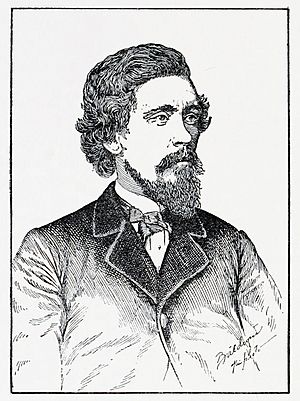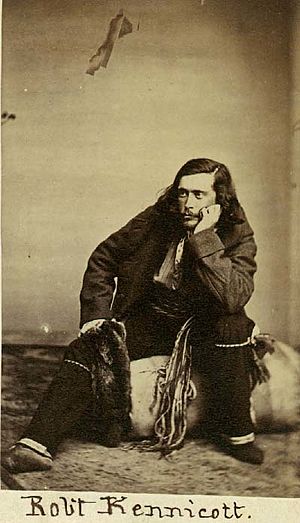Robert Kennicott facts for kids
Quick facts for kids
Robert Kennicott
|
|
|---|---|
 |
|
| Born | November 13, 1835 New Orleans, Louisiana, U.S.
|
| Died | May 13, 1866 (aged 30) Near Fort Nulato, Russian America
|
| Nationality | American |
| Scientific career | |
| Fields | Zoology, herpetology |
Robert Kennicott (born November 13, 1835 – died May 13, 1866) was an American naturalist and herpetologist. A naturalist studies plants and animals. A herpetologist specifically studies reptiles and amphibians.
Robert was often sick as a child, so he didn't go to school much. Instead, he spent a lot of time outside. He loved collecting plants and animals. His father taught him at home. He also helped Robert learn from a famous naturalist named Jared Potter Kirtland. Soon, Robert was sending animal samples to the Smithsonian Institution. He worked with Spencer Fullerton Baird, who was a helper there.
Robert believed it was important to study and protect wild prairie animals. This was at a time when many farmers wanted to get rid of them. In 1857, he worked with Northwestern University to start a natural history museum. He also helped create the Chicago Academy of Sciences. In Chicago, he was a mentor to younger naturalists, like William Healey Dall. He joined a group called the Megatherium Club. He also studied animals in Hudson Bay.
In the mid-1860s, the Western Union Telegraph Expedition hired Robert as a scientist. He sadly died during this trip. Today, places in Alaska like the Kennicott Glacier are named after him. His family home, "The Grove" in Glenview, Illinois, is now a National Historic Landmark.
Contents
Robert's Early Life and Learning
Robert Kennicott was born in New Orleans, Louisiana, on November 13, 1835. His father, John Albert, loved plants. He owned a large piece of land in Northfield Township, Cook County, Illinois. This land became known as "The Grove".
Robert was often sick when he was young. He tried to get healthier by spending lots of time outdoors. He didn't go to school regularly. But his father made sure he learned at home. His father taught him to carefully watch nature. This is how Robert started collecting animal samples.
Learning from a Famous Naturalist
In late 1852, Jared Potter Kirtland agreed to teach Robert. Kirtland was a friend of Robert's father. He was also one of the best naturalists in the western United States. Robert spent the winter with Kirtland in East Rockport (now Lakewood), Ohio.
Kirtland told Robert to get in touch with other naturalists. Soon, Robert got the attention of Spencer Fullerton Baird. Baird was the assistant secretary at the Smithsonian Institution. For the next thirteen years, Robert wrote to Baird about his discoveries. Illinois was still largely unexplored by naturalists. So, Baird encouraged Robert to send him animal samples.
Studying Illinois Animals
In 1855, the Illinois Central Railroad asked the Illinois State Agricultural Society to study the state's natural resources. Robert's father was the secretary of this group. He suggested Robert for the job.
After this trip, Robert wrote a list of animals found in Cook County. The first new animal Robert found was a snake from Northern Illinois. He sent it to Baird. Baird suggested Robert name the snake after Kirtland. It was called Regina kirtlandii. Today, it's known as Clonophis kirtlandii.
From 1856 to 1858, Robert wrote a three-part paper. It was called "The Quadrupeds of Illinois, Injurious and Beneficial to the Farmer". In this paper, Robert asked farmers to study wild animals before trying to get rid of them.
Starting Museums and Clubs
In early 1857, Northwestern University asked Robert for help. They wanted to create a natural history museum. Later that year, Robert also helped start the Chicago Academy of Sciences.
For the next two winters, Robert worked at the Smithsonian in Washington, D.C.. He helped Baird organize their collections of amphibians and reptiles. There, he met William Stimpson. He also became part of the Megatherium Club, a group of young scientists.
Expeditions and Discoveries

In April 1859, Robert went on a trip to collect animal samples. He traveled to the cold, northern forests of northwestern Canada. This area is now the Mackenzie and Yukon river valleys. He also explored the very cold Arctic tundra.
Robert became popular with the Hudson's Bay Company fur traders there. He encouraged them to collect and send animal samples and First Nations artifacts to the Smithsonian. He returned to Washington at the end of 1862.
Robert thought about joining the Union Army during the Civil War. But he was convinced not to. He sent someone else to take his place. Robert and his younger brother lived in the Smithsonian Castle during the war. Other famous naturalists, like Edward Drinker Cope, lived there too. In 1863, Robert went back to Illinois to care for his sick father. His father died later that year.
While working at the Smithsonian, Robert wrote about many new types of snakes. These snakes were brought back from trips to the American West.
The Western Union Telegraph Expedition
In 1864, the Western Union Telegraph Expedition began. Its goal was to find a way to build a telegraph line between North America and Russia. This line would go across the Bering Sea. Robert was chosen as the main scientist for this trip. Other naturalists, like W.H. Dall, joined him.
The expedition arrived in San Francisco in April 1865. But the leaders disagreed, so not much was done. The group moved north to Vancouver. There, Robert got sick for a while. After he got better, they moved north again to Alaska in August 1865. Robert died in May 1866 while traveling up the Yukon River.
Years later, from 2001 to 2016, scientists at the Smithsonian studied his death. They believe he died from a heart attack. With his family's permission, his body was added to the human anatomy collection at the Smithsonian.
Robert Kennicott's Legacy
Robert's body was sent back to his family's home in Illinois. It took about a year and went almost all the way around the world. His body was put in a metal container and shipped to Russia and Japan. It was not sent back through the undeveloped trails in Canada. Meanwhile, on March 30, 1867, Secretary of State William H. Seward bought Alaska from Russia.
To remember his work for science, several places are named after him. These include Kennicott Glacier, Kennicott Valley, the MV Kennicott ship, and the Kennicott River. The town of Kennecott is famous for its rich copper mines. It was named because it was close to the glacier. However, the town's name was spelled a little differently. Natural places kept the original spelling of his name. The mines and businesses kept the different spelling.
Also, two birds are named after Robert Kennicott. They are the western screech owl (Megascops kennicottii) and the Alaskan Arctic Warbler (Phylloscopus borealis kennicottii).
Some of Robert's papers are kept at Northwestern University. Others are at his family home, The Grove. This home is a National Historic Landmark in Glenview, Illinois. His original grave is still there in a family burial plot. His papers can also be found on microfilm at the Glenview Public Library.
The Smithsonian Institution made a 3-D reconstruction of his face. They scanned his skull. Then, they used computers to rebuild his face. A 3-D copy of the skull was made. A sculptor then used clay to create his face on the copy.
A nature writer named Donald Culross Peattie wrote about Robert's life. It was in Peattie's book, "The Road of a Naturalist." Peattie had spent time at Kennicott's Grove when he was a child.
Images for kids


